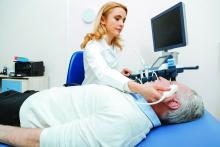Temporal artery ultrasound alone was sufficient to accurately diagnose giant cell arteritis (GCA) in over half of patients in a new prospective study.
The findings provide further evidence that “[ultrasound] of temporal arteries could really take the place of traditional temporal artery biopsy (TAB)” in patients with high clinical suspicion of GCA, lead author Guillaume Denis, MD, of the Centre Hospitalier de Rochefort in Rochefort, France, told this news organization.
The European Alliance of Associations for Rheumatology (EULAR) already recommends ultrasound as a first-line diagnostic tool for patients with suspected large vessel vasculitis, and the 2022 American College of Rheumatology (ACR)/EULAR classification criteria for GCA weighs positive TAB or temporal artery halo sign on ultrasound equally.
Guidelines from the ACR and the Vasculitis Foundation still recommend TAB over ultrasound.
“In general, rheumatologists and radiologists in the US are less experienced in using ultrasound to diagnose temporal artery involvement in GCA compared to their counterparts in Europe,” the 2021 guidelines stated. “In centers with appropriate training and expertise in using temporal artery ultrasound, ultrasound may be a useful and complementary tool for diagnosing GCA.”
Methodology
In the study, researchers recruited 165 individuals with high clinical suspicion of GCA from August 2016 through February 2020 at six French hospitals. Only patients older than 50 years of age and with biologic inflammatory syndrome with C-reactive protein elevation (≥ 6 mg/L) qualified for the study. Patients also needed to have at least one of these factors:
- Clinical signs of GCA (abnormal temporal arteries, scalp hyperesthesia, jaw claudication, or vision loss)
- General signs of GCA (headache, fever, or impaired general condition)
- Large-vessel vasculitis visible on imaging (CT angiography [CTA], MR angiography [MRA], and/or PET/CT)
All participants underwent a color Doppler ultrasound of the temporal artery, performed less than 1 week after the initiation of corticosteroid therapy. (Previous research demonstrated that corticosteroids can change the hallmark halo sign of vasculitis detectable via ultrasound as early as 1 week after initiation of therapy, the authors noted.) In this study, the time between consultation with a specialist and ultrasound was less than 1 day.
“Patients with halo signs detected around the lumen of both temporal arteries (that is, bilateral temporal halo sign) were considered as ultrasound-positive,” Guillaume Denis, MD, and colleagues explained. “Patients with no halo sign, or bilateral halo signs in the axillary arteries, or a unilateral halo sign in the temporal artery were considered as ultrasound-negative.”
The findings were published in Annals of Internal Medicine on May 7.
Results
In total, 73 participants (44%) had positive ultrasounds and were diagnosed with GCA. These patients also underwent a second ultrasound a month later to document if the halo sign remained unchanged, reduced, or disappeared.
The remaining 92 patients with negative ultrasound results underwent TAB, which was conducted on average 4.5 days after the ultrasound. A total of 28 patients (30%) had a positive TAB result. Physicians diagnosed 35 TAB-negative patients with GCA using clinical, imaging, and biologic data, and 29 patients received alternative diagnoses. These other diagnoses included polymyalgia rheumatica, infectious diseases, cancer, and other systemic inflammatory rheumatic diseases.
All patients diagnosed with GCA via ultrasound had their diagnoses reconfirmed at 1 month and for up to 2 years of follow-up.
“In summary, our study showed that the use of temporal artery ultrasound may be an efficient way to make the diagnosis of GCA in patients with high clinical suspicion and to reduce imaging costs and the need for biopsy, thereby limiting complications and the need for a surgeon,” the authors concluded.


